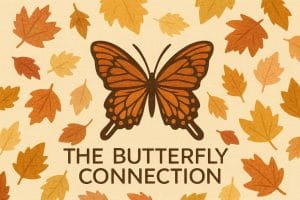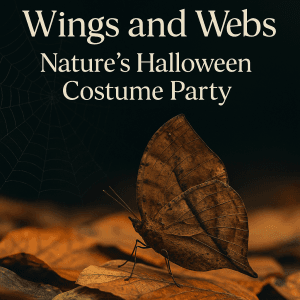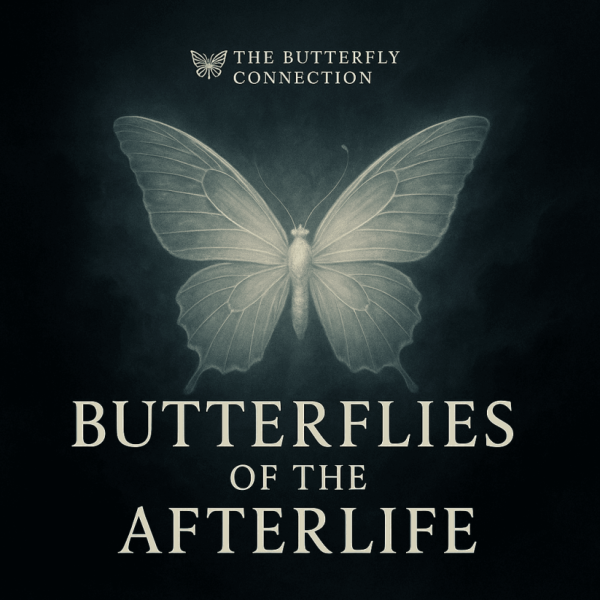
While you’re picking out a Halloween costume, nature’s already ahead of you. From wings that look like dead leaves to patterns that scream “Don’t eat me!”, butterflies and insects have been mastering disguise long before humans ever raided the seasonal aisle. This week, we’re pulling back the curtain on nature’s ultimate masquerade — and how you can bring some of that wild magic home with real butterfly art.
1. The “I’m a Dead Leaf” Look
Imagine perching on a branch, wings folded, looking every bit like a crumpled brown leaf. That’s not a Halloween prop — it’s the Oakleaf Butterfly (Kallima inachus), one of nature’s finest illusionists. Its top wings are vibrant blue and orange, but when closed, they mimic a decaying leaf right down to the veins and shadow.
Scientists recently uncovered the genetic secret behind this disguise — the butterfly’s ability to “switch” between brilliant color and dull camouflage comes from a unique gene blend. (Courthouse News)
As the days shorten and leaves litter the ground, the Oakleaf Butterfly becomes the ultimate example of seasonal style: beautiful, mysterious, and perfectly in tune with autumn.
💡 Home décor idea: Frame a naturally camouflaged butterfly species alongside muted fall tones — the contrast of hidden beauty and visible elegance makes for an unforgettable wall statement.
2. Bold, Bright, and Unbothered: The “Don’t Touch Me” Costume
While some species hide, others flaunt. The Viceroy Butterfly, for instance, struts around in the same orange-and-black outfit as the famous Monarch — but this copycat isn’t faking it. For years, scientists thought it was simply mimicking the Monarch’s toxic warning colors (known as Batesian mimicry), but new research shows both species are actually distasteful to predators. That makes it Müllerian mimicry — two unappetizing insects teaming up to double their defense. (Wikipedia: Viceroy Butterfly)
It’s nature’s version of “don’t mess with us.” Bold colors say I’m confident, and for these butterflies, confidence equals survival.
💡 Decor tip: Take a cue from these fearless fliers — orange and black aren’t just for pumpkins. They make a daring, modern color palette for your fall display wall. Pair framed butterfly art with natural textures like bark, dried moss, and soft lighting for a moody, sophisticated Halloween aesthetic.
3. The Vanishing Act: Camouflage and Deception
Then there are the subtle tricksters — species that blur so completely into bark or foliage that even their predators miss them. Many butterflies use eyespots to imitate larger animals or blend into their backgrounds, confusing everything from birds to lizards. (Explorable.com)
This is the ultimate “invisible costume” — a masterclass in the art of not being seen. From leaf-wing butterflies to bark-patterned moths, nature proves that sometimes the best disguise is simply fitting in perfectly.
💡 Decor tip: Try creating your own version of camouflage by arranging artwork and specimens subtly into your décor — a butterfly tucked among framed ferns or nestled near wood textures adds an element of discovery for guests.
Why Butterflies Belong in Halloween’s Spotlight
Halloween may be about ghosts and ghouls, but nature’s transformations are the real magic show. These butterflies teach us that disguise can be beautiful, that adaptation is art, and that sometimes hiding in plain sight is the most dramatic move of all.
So this spooky season, skip the fake cobwebs and let the real wonders of the natural world take center stage.
🦋 Explore nature’s best disguises — visit The Butterfly Connection to discover real framed butterfly art and resin-encased specimens, each piece celebrating the science and beauty of nature’s Halloween costume party.
External reading:
Florida Museum: Camouflage & Mimicry in Butterflies
Wired: Insects and Spiders That Disguise Themselves
Britannica: 9 Animals That Look Like Leaves
Share:
Social Media
Most Popular
Subscribe To Our Newsletter
Categories
- Education (27)
- Family (5)
- Fun Facts (19)
- Inspiration (26)
- Local (2)
- News (1)
- Science (7)
- Technology (2)
Related Posts

Hibernate, Hide, or Head South: The Great Butterfly Winter Debate
When it comes to escaping winter, butterflies have options. Monarchs grab the spotlight, fluttering thousands of miles to Mexico like tiny orange tourists chasing the

Wings and Webs: Nature’s Halloween Costume Party
While you’re picking out a Halloween costume, nature’s already ahead of you. From wings that look like dead leaves to patterns that scream “Don’t eat

Butterflies of the Afterlife: How Cultures Around the World See Souls in Flight
Wings Between Worlds: A Timeless Belief Since ancient times, butterflies have been seen as more than mere insects — they’ve been viewed as messengers between

Real Resin-Encased Scorpions Are This Season’s Darkest Décor Trend
When Nature Gets a Little Dangerous Forget plastic pumpkins and foam spiders—this Halloween, the décor trend with real sting is authentic resin-encased scorpions. Each one,

While you’re picking out a Halloween costume, nature’s already ahead of you. From wings that look like dead leaves to patterns that scream “Don’t eat me!”, butterflies and insects have been mastering disguise long before humans ever raided the seasonal aisle. This week, we’re pulling back the curtain on nature’s ultimate masquerade — and how you can bring some of that wild magic home with real butterfly art.
1. The “I’m a Dead Leaf” Look
Imagine perching on a branch, wings folded, looking every bit like a crumpled brown leaf. That’s not a Halloween prop — it’s the Oakleaf Butterfly (Kallima inachus), one of nature’s finest illusionists. Its top wings are vibrant blue and orange, but when closed, they mimic a decaying leaf right down to the veins and shadow.
Scientists recently uncovered the genetic secret behind this disguise — the butterfly’s ability to “switch” between brilliant color and dull camouflage comes from a unique gene blend. (Courthouse News)
As the days shorten and leaves litter the ground, the Oakleaf Butterfly becomes the ultimate example of seasonal style: beautiful, mysterious, and perfectly in tune with autumn.
💡 Home décor idea: Frame a naturally camouflaged butterfly species alongside muted fall tones — the contrast of hidden beauty and visible elegance makes for an unforgettable wall statement.
2. Bold, Bright, and Unbothered: The “Don’t Touch Me” Costume
While some species hide, others flaunt. The Viceroy Butterfly, for instance, struts around in the same orange-and-black outfit as the famous Monarch — but this copycat isn’t faking it. For years, scientists thought it was simply mimicking the Monarch’s toxic warning colors (known as Batesian mimicry), but new research shows both species are actually distasteful to predators. That makes it Müllerian mimicry — two unappetizing insects teaming up to double their defense. (Wikipedia: Viceroy Butterfly)
It’s nature’s version of “don’t mess with us.” Bold colors say I’m confident, and for these butterflies, confidence equals survival.
💡 Decor tip: Take a cue from these fearless fliers — orange and black aren’t just for pumpkins. They make a daring, modern color palette for your fall display wall. Pair framed butterfly art with natural textures like bark, dried moss, and soft lighting for a moody, sophisticated Halloween aesthetic.
3. The Vanishing Act: Camouflage and Deception
Then there are the subtle tricksters — species that blur so completely into bark or foliage that even their predators miss them. Many butterflies use eyespots to imitate larger animals or blend into their backgrounds, confusing everything from birds to lizards. (Explorable.com)
This is the ultimate “invisible costume” — a masterclass in the art of not being seen. From leaf-wing butterflies to bark-patterned moths, nature proves that sometimes the best disguise is simply fitting in perfectly.
💡 Decor tip: Try creating your own version of camouflage by arranging artwork and specimens subtly into your décor — a butterfly tucked among framed ferns or nestled near wood textures adds an element of discovery for guests.
Why Butterflies Belong in Halloween’s Spotlight
Halloween may be about ghosts and ghouls, but nature’s transformations are the real magic show. These butterflies teach us that disguise can be beautiful, that adaptation is art, and that sometimes hiding in plain sight is the most dramatic move of all.
So this spooky season, skip the fake cobwebs and let the real wonders of the natural world take center stage.
🦋 Explore nature’s best disguises — visit The Butterfly Connection to discover real framed butterfly art and resin-encased specimens, each piece celebrating the science and beauty of nature’s Halloween costume party.
External reading:
Florida Museum: Camouflage & Mimicry in Butterflies
Wired: Insects and Spiders That Disguise Themselves
Britannica: 9 Animals That Look Like Leaves
While you’re picking out a Halloween costume, nature’s already ahead of you. From wings that look like dead leaves to patterns that scream “Don’t eat me!”, butterflies and insects have been mastering disguise long before humans ever raided the seasonal aisle. This week, we’re pulling back the curtain on nature’s ultimate masquerade — and how you can bring some of that wild magic home with real butterfly art.
1. The “I’m a Dead Leaf” Look
Imagine perching on a branch, wings folded, looking every bit like a crumpled brown leaf. That’s not a Halloween prop — it’s the Oakleaf Butterfly (Kallima inachus), one of nature’s finest illusionists. Its top wings are vibrant blue and orange, but when closed, they mimic a decaying leaf right down to the veins and shadow.
Scientists recently uncovered the genetic secret behind this disguise — the butterfly’s ability to “switch” between brilliant color and dull camouflage comes from a unique gene blend. (Courthouse News)
As the days shorten and leaves litter the ground, the Oakleaf Butterfly becomes the ultimate example of seasonal style: beautiful, mysterious, and perfectly in tune with autumn.
💡 Home décor idea: Frame a naturally camouflaged butterfly species alongside muted fall tones — the contrast of hidden beauty and visible elegance makes for an unforgettable wall statement.
2. Bold, Bright, and Unbothered: The “Don’t Touch Me” Costume
While some species hide, others flaunt. The Viceroy Butterfly, for instance, struts around in the same orange-and-black outfit as the famous Monarch — but this copycat isn’t faking it. For years, scientists thought it was simply mimicking the Monarch’s toxic warning colors (known as Batesian mimicry), but new research shows both species are actually distasteful to predators. That makes it Müllerian mimicry — two unappetizing insects teaming up to double their defense. (Wikipedia: Viceroy Butterfly)
It’s nature’s version of “don’t mess with us.” Bold colors say I’m confident, and for these butterflies, confidence equals survival.
💡 Decor tip: Take a cue from these fearless fliers — orange and black aren’t just for pumpkins. They make a daring, modern color palette for your fall display wall. Pair framed butterfly art with natural textures like bark, dried moss, and soft lighting for a moody, sophisticated Halloween aesthetic.
3. The Vanishing Act: Camouflage and Deception
Then there are the subtle tricksters — species that blur so completely into bark or foliage that even their predators miss them. Many butterflies use eyespots to imitate larger animals or blend into their backgrounds, confusing everything from birds to lizards. (Explorable.com)
This is the ultimate “invisible costume” — a masterclass in the art of not being seen. From leaf-wing butterflies to bark-patterned moths, nature proves that sometimes the best disguise is simply fitting in perfectly.
💡 Decor tip: Try creating your own version of camouflage by arranging artwork and specimens subtly into your décor — a butterfly tucked among framed ferns or nestled near wood textures adds an element of discovery for guests.
Why Butterflies Belong in Halloween’s Spotlight
Halloween may be about ghosts and ghouls, but nature’s transformations are the real magic show. These butterflies teach us that disguise can be beautiful, that adaptation is art, and that sometimes hiding in plain sight is the most dramatic move of all.
So this spooky season, skip the fake cobwebs and let the real wonders of the natural world take center stage.
🦋 Explore nature’s best disguises — visit The Butterfly Connection to discover real framed butterfly art and resin-encased specimens, each piece celebrating the science and beauty of nature’s Halloween costume party.
External reading:
Florida Museum: Camouflage & Mimicry in Butterflies
Wired: Insects and Spiders That Disguise Themselves
Britannica: 9 Animals That Look Like Leaves





